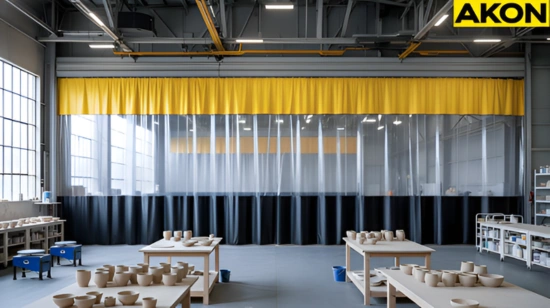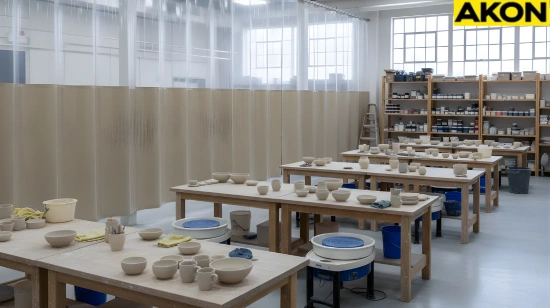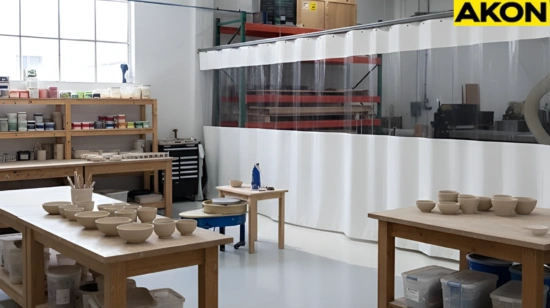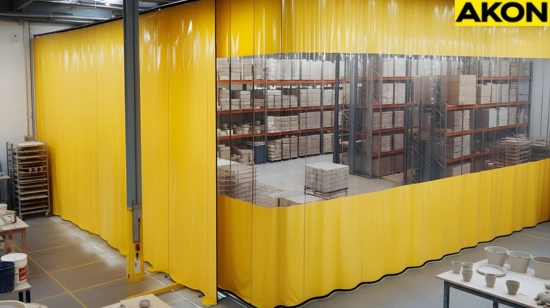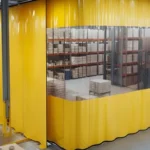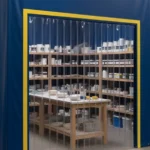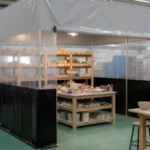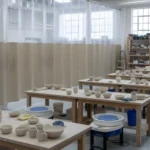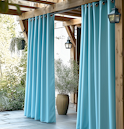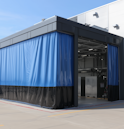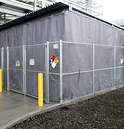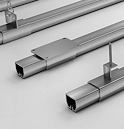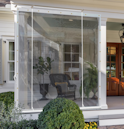Ceramic Studio Curtains
Clay dust often drifts into glazing areas and causes defects, uneven drying, and contamination. This guide explores how using a glazing room curtain improves dust control and airflow. You will also learn how these dividers compare to other methods, which products fit studio needs, and answers to common dust control pottery studio questions.
How Curtain Walls Solve Your Studio’s Separation Challenges
Creating a cleaner and more organized workspace starts with separating your clay and glazing zones in a simple way. A glazing room curtain helps you form a dedicated area that supports better results without construction. This section explains how these dividers improve daily studio use and why their features work well for different pottery studio layouts.
How Curtain Walls Improve Studio Separation
A glazing room curtain gives your studio a defined workspace that keeps activities organized without using permanent walls. The divider helps limit how far clay particles move, which makes glazing surfaces easier to maintain throughout the day. It also supports steadier airflow between work areas, which assists with drying times and glaze preparation.
This creates a more consistent environment for routine tasks and improves the overall flow of your projects. This makes your studio easier to manage even during busy work periods.
Why Curtain Wall Features Fit Pottery Studio Needs
Many pottery studios prefer this setup because it performs well in both compact and open spaces. The vinyl panels are durable and simple to clean, which suits daily clay work. Custom sizing helps the divider fit tight corners or wide sections, while the modular track system lets you adjust the shape based on your layout.
Installation is quick, making this a practical glazing room curtain solution for improving studio organization. This gives you more flexibility as your workspace or class schedule changes.
Key Benefits for Ceramic Studios
Once your clay and glazing areas are separated, the right divider can support a cleaner, more organized studio. A glazing room curtain offers practical improvements that help your workspace run more smoothly. Below are the three main benefits many pottery studios find helpful.
• Better dust control: Helps limit the amount of clay dust reaching your glazing area for cleaner and more consistent results. This keeps glazing tables clearer throughout the day. It also helps reduce time spent wiping and resetting your workspace so you can focus more on creating.
• Improved airflow and moisture balance: Creates steadier conditions that support more predictable drying and glazing. This reduces sudden changes that might affect newly glazed pieces. It also helps keep your studio environment more comfortable and easier to manage.
• Flexible layout options: Allows your studio space to adapt easily as your work style or equipment needs change. This makes it simple to adjust your setup for classes or new tools. It also helps your studio stay organized even as your workflow grows or shifts.
Better Dust Control
The vinyl surface helps reduce how much clay dust reaches your glazing area so your finishes stay cleaner.
Improved Airflow and Moisture Balance
The divider supports steadier airflow between zones which helps drying pieces and freshly glazed items set more evenly.
Flexible Studio Layout
The modular track design makes it easy to adjust or expand your layout as your studio equipment or workflow changes.
Curtain Walls vs Other Studio Separation Methods
If you are deciding how to divide your clay and glazing areas, it helps to see how different options perform side by side. Each method has its strengths, and the right choice depends on your budget, space, and how often you adjust your studio layout. The table below gives a quick overview to help you compare your options.
| Method | Advantages | Limitations |
|---|---|---|
| Permanent drywall | Strong barrier, long lasting | High cost, not flexible, long install time |
| Plastic sheets or tarps | Low cost, quick setup | Poor sealing, lets dust through, looks temporary |
| Curtain walls | Great dust control, clean appearance, flexible, budget friendly | Requires accurate measurement and mounting |
A glazing room curtain offers a practical middle option because it gives you reliable separation without the cost or permanence of construction. It creates a cleaner look than temporary barriers and supports better zone control for most pottery studios. This makes it a helpful choice for improving your workspace without committing to major changes.
Material Options
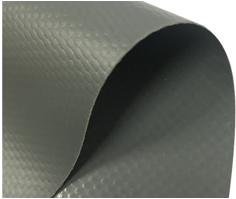
18 oz Reinforced Vinyl (standard)
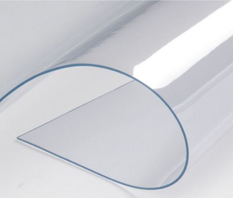
20 mil Clear PVC For Clarity
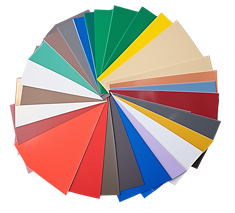
Available in Multiple Colors
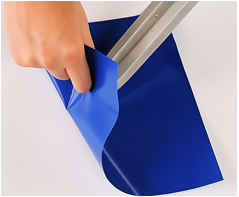
Strong Materials
Recommended Vinyl Enclosure Products for Ceramic Studios
Now that you know how different separation methods compare, the next step is choosing the enclosure that best fits your studio’s needs. Below are three vinyl enclosure options that work especially well for pottery and glazing spaces.
Clear Vinyl Enclosures
Clear vinyl enclosures are a strong choice when you want separation without losing visibility between zones. They help keep clay and glazing areas divided while still allowing you to monitor activity across your studio.
• Helps you supervise glazing tables or student work without opening the divider
• Keeps clay dust away from glazing areas while maintaining sightlines
• Works well for teaching studios or shared workspaces
• Ideal for open layouts that benefit from transparent zone control
Opaque Vinyl Enclosures
Opaque vinyl enclosures work well when your studio needs privacy and a more defined workspace. They create a solid barrier that separates tasks and reduces visual distractions across different zones.
• Helps create a focused glazing or clay-prep area
• Provides a clean, solid look that hides movement in adjacent zones
• Easy to wipe down and maintain during daily studio use
• Great for studios wanting a more private glazing room curtain option
Insulated Vinyl Enclosures
Insulated vinyl enclosures are designed for studios that require steadier temperature or humidity between clay and glazing spaces. They help support consistent results when your workflow depends on controlled conditions.
• Helps maintain more stable conditions for drying and glazing
• Reduces airflow transfer between areas with different activity levels
• Supports better performance near kilns or damp zones
• Useful for studios that work year-round in changing weather conditions
Frequently Asked Questions
FAQs for Ceramic Studios Using Vinyl Enclosures
Will a glazing room curtain really help with clay dust control?
Yes. Both Opaque Vinyl Enclosures and Clear Vinyl Enclosures help limit how far clay dust travels, giving your glazing area a cleaner surface to work on. Studios often choose them for better dust control pottery studio setups.
Can I use vinyl enclosures even if my studio is rented?
Yes. Clear Vinyl and Opaque Vinyl Enclosures mount to simple track systems, so most renters can install them without major changes to the space.
What type of vinyl enclosure works best for separating my clay area from my glazing area?
Opaque Vinyl Enclosures usually work best because they provide a solid, private barrier between zones. Clear Vinyl Enclosures are better if you want visibility while keeping areas separated.
Will an insulated vinyl enclosure help stabilize humidity around my glazing table?
Yes. Insulated Vinyl Enclosures help steady temperature and moisture, which supports more consistent drying and glazing results.
Can I move the glazing room curtain if I rearrange my studio later?
Yes. Track-mounted vinyl enclosures are designed to be repositioned or expanded as your pottery studio layout changes.
Are Clear Vinyl Enclosures safe for use near glazing chemicals?
Yes. Clear vinyl is durable, easy to wipe clean, and commonly used in glazing rooms where visibility and cleanliness matter.
How do I choose between clear, opaque, and insulated vinyl?
Choose Clear Vinyl Enclosures for visibility, Opaque Vinyl Enclosures for privacy, and Insulated Vinyl Enclosures for better environmental control.
Will a vinyl enclosure make my small studio feel cramped?
No. Vinyl enclosures can be sized to fit tight areas and often make small pottery studios feel more organized.
Can I create separate clay prep and glazing zones using vinyl enclosures?
Yes. Many studios use a combination of Clear Vinyl and Opaque Vinyl Enclosures to divide multiple workstations within one space.
Are vinyl enclosures easy to clean after clay work?
Yes. All vinyl types wipe down quickly with basic cleaners, which helps reduce daily cleanup time.
Do I need special tools to install a glazing room curtain?
No. Most Clear Vinyl and Opaque Vinyl Enclosures install with simple track hardware, making setup easy for DIY studio owners.
Will insulated vinyl help maintain drying consistency for pottery pieces?
Yes. Insulated Vinyl Enclosures help limit temperature swings that affect drying, especially near kilns or damp areas.
Can vinyl enclosures work in basement or garage pottery studios?
Yes. They fit most indoor spaces and help clearly separate clay and glazing areas.
Are vinyl enclosures safe to place near pottery wheels or splash zones?
Yes. Vinyl panels are strong enough to handle moisture from wheel work and are simple to wipe clean.
Can I enclose my glazing table without blocking visibility to the rest of the studio?
Yes. Clear Vinyl Enclosures give you separation while still letting you see across the workspace.
What size vinyl enclosure is best for a small glazing room?
Measure the width and height of the area you want to enclose, then match those dimensions with Clear or Opaque Vinyl Enclosures that fit the space.
Will vinyl enclosures help reduce cross-contamination during group classes?
Yes. They create clean, defined zones that help keep clay work and glazing areas from affecting each other.
Can I use insulated vinyl near my kiln?
Yes. Insulated Vinyl Enclosures work well near areas with temperature changes and help stabilize nearby workspace conditions.
How long do Clear or Opaque Vinyl Enclosures last in a pottery studio?
They are built for frequent use and hold up well for years, even in busy clay and glazing spaces.
Do I need to hire a professional to install vinyl enclosures?
Not usually. Most pottery studios install Clear, Opaque, or Insulated Vinyl Enclosures on their own by following the track system instructions.
Create a Better Workspace for Your Glazing and Clay Areas
A clear divider between your clay and glazing areas helps your studio stay cleaner, more consistent, and easier to work in each day. Vinyl enclosures give you a simple way to improve workspace control without construction, supporting better glaze results and a more organized layout. If you’re ready to upgrade your studio, explore our glazing room curtain options or request a custom quote today.



